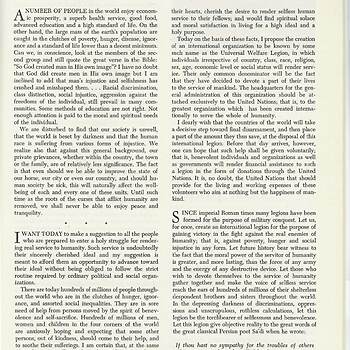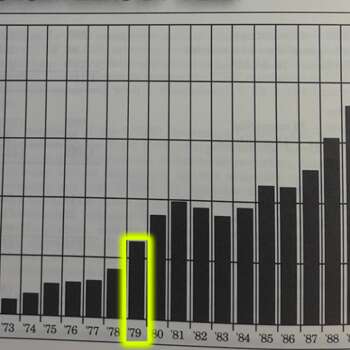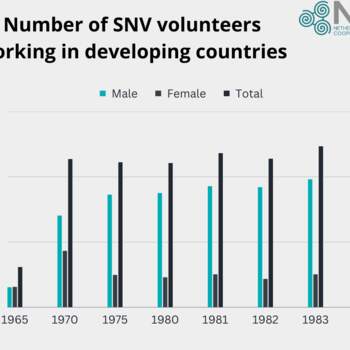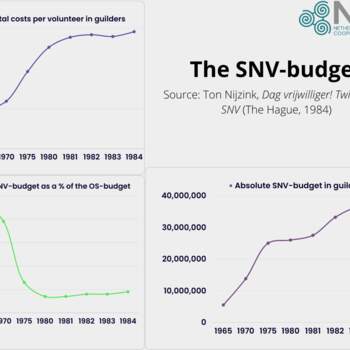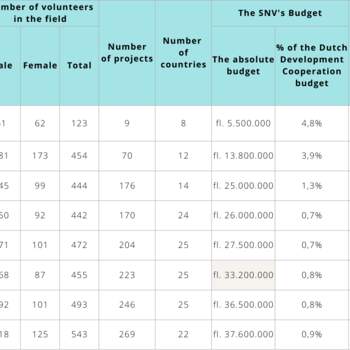The foundation of the United Nations Volunteers
In 1970, two years after the Shah of Iran, Mohammed Reza Pahlavi called for the establishment of a global volunteer service in response to establishment of national volunteer services like the American Peace Corps. The UN General Assembly voted in favour of such an organisation, see the UN General Assembly Resolution 2659. From this campaign, the United Nations Volunteers (UNV) was born. It falls under the purview of the United Nations Development Programme (UNDP) and is funded by the Special Voluntary Fund (SVF).
In 1971, the first 35 UN Volunteers were sent to Chad, Yemen and East Pakistan (now Bangladesh). Depending on the needs of the country and the requirements of the projects, a number of UN organisations may become involved, from the UNDP to the United Nations International Children's Emergency Fund(UNICEF) and the Food and Agriculture Organisation of the UN (FAO). Following its establishment and the success of its first few missions, in 1972, the UNV established its headquarters in Geneva, Switzerland. To read more about the UNV and its history, click here.
The SNV in the 1970s and the establishment of the KNV
In 1970 a group of returning SNV-volunteers (The Dutch Volunteer Foundation) formed the Contact Group of Dutch Volunteers (Kontaktgroep Nederlandse Vrijwilligers, KNV). This new organisation cooperated with the SNV to organise weekend sessions for people interested in working as a volunteer in ‘the Third World’. The goal for these weekends was two-fold: giving interested people insight on the realities of working in poor overseas countries and instruct them on the harmful relationship s between the 'First World' and the 'Third World.'
Topics touched upon regarding the latter objective were, for example unequal trade relations, the strong influence of international institutions like the IMF and the World Bank, and the effects of big multinational organisations on poor countries (i.e., oil companies, pharmaceutical companies, artificial fertilisers, pesticide firms, etc.)
The second objective was expected to motivate people without plans to leave the Netherlands, to become involved in advocacy campaigns in favour of interests of poor countries, and to influence policy and practice in the Netherlands.
After Kees Boertien became Minister for Development Cooperation, the ex-volunteers, represented through the KNV, got two seats on the board of the SNV in 1972. Then, his successor, Jan Pronk, allowed an increase in the influence of the KNV in the SNV organisation, and as such, the organisational reach grew exponentially in its early years. However, cooperation between the SNV and the KNV presented a number of difficulties over the years; While the former institution was bureaucratic, the latter was largely volunteer-based with lesser respect for authority. Both institutions differed largely regarding the tools needed to achieve the goals of the SNV, which led to vocal disagreements. Two of these disagreements will be discussed below, and centred around the so-called B objective and the democratisation process of the organisation.
The B Objective
In 1974, Prince Claus becomes chairman of the SNV as he was forced to leave the NCO (read more here). In the same year, the SNV added a new objective to its mission, i.e., the B Objective, where the ‘B’ stands for awareness (bewustwording). In short, this novel objective was to promote awareness in Dutch society about topics such as development issues and the role laid out for the SNV in Dutch Development and providing aid. The B Objective was set to complement the A Objective, or the mandate for placing volunteers in developing countries. In its early stages, the SNV leveraged its magazine, Vice Versa, as a key tool to fulfil the B Objective.
This objective was incorporated officially into SNV policy three years later, in 1977. Later, when the SNV was renamed from Dutch Volunteer Foundation to Organisation for Development Cooperation and Awareness (Organisatie voor Ontwikkelingssamenwerking and Bewustwording, SNV) in 1981, the B Objective was enshrined into its name too. Nevertheless, the B objective was one of the points of contention between the SNV and the KNV. While several SNV board members understood the B Objective as a tool to increase the SNV's publicity and emphasise its necessity in addressing development issues, former volunteers disagreed. They found the SNV to be already overly present in the Dutch media, taking away attention from the real goal of Dutch development aid.
Democratisation
As mentioned before, another point of contention within the SNV and between the KNV and SNV was the call for democratisation, and from 1973, the organisation saw continuous internal disagreement. Even though the volunteers achieved a larger say within the organisation over time through the KNV, the relations between private companies and the government remained strained. As a result, private organisations departed from the SNV in 1978, when the government began awarding them their own subsidies. From this point forward, the SNV Board was made up out of 6 appointees from the MFA, 2 representatives from the JVC, 2 from the KNV, one appointed by the government, as well as 3 members of the fields staff or volunteers that had just returned to the Netherlands.
However, the KNV had substantial influence among volunteers, both returned and still abroad. Its meetings were often attended by more than 250 people., and the ideas of their people were considered influential on SNV policy. The group consisted of people who had joined for the social aspect of gathering with other former volunteers, as well as politically motivated people, trying to push the board (even further) to the political left. At the same time, the SNV faced pressure from the Dutch right-wing media, who considered development spending a waste of money. This led the KNV to look for a balancing act, criticising the SNV but also defending it against its adversaries.
Sources and further reading:
- Brinkman, I. (2010). Bricks, Mortar and Capacity Building: A Socio-Cultural History of SNV Netherlands Development Organisation. Leiden [etc.]: Brill.
- Verhoeven, D. (2002). Aid - a changing necessity: SNV: from volunteers to advisors. SNV Dutch Development Organisation.
- United Nations Volunteers History
- Programma evaluatie SNV, SNV goed bekeken! (The Hague, 1985)
- Ton Nijzink, Dag vrijwilliger! Twintig jaar SNV (The Hague, 1984)
